Any list of essential gear for hiking will always include a compass. Even if you have some kind of GPS device, the advice is still also to carry a compass. In a worst-case scenario, a compass can literally save your life. There are, however, a lot of different compasses available. This is our round-up of the best compasses for hiking.
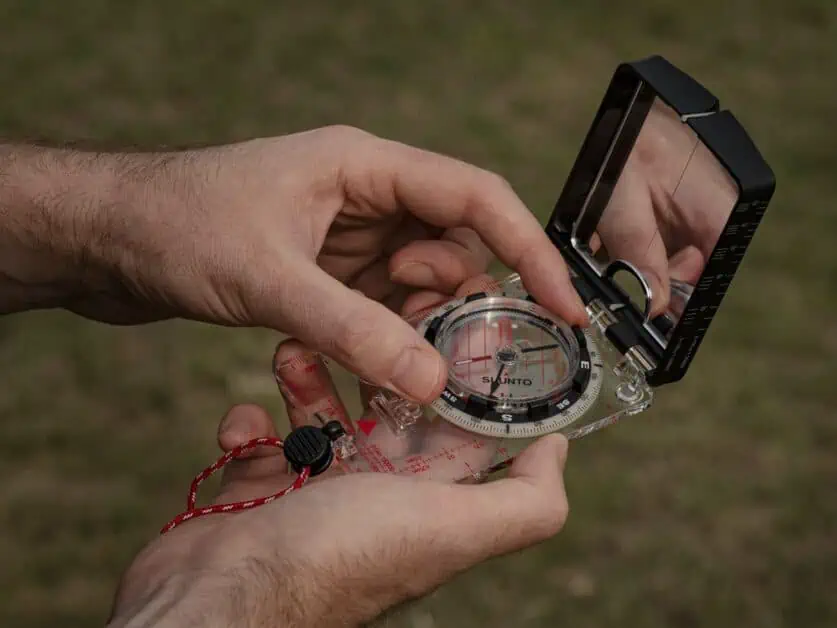
Editor’s Note: This article is part of our overall guide to the best hiking compasses. Check out our other guides:
Types of Compass
While there are various different kinds of compasses when it comes to hiking, we are talking about magnetic compasses. This type of compass uses Earth’s magnetic field to determine direction. It consists of a magnetic needle that aligns itself with the Earth’s magnetic North and South poles. The needle is mounted on a pivot, allowing it to move freely. When the compass is held level and away from magnetic interference, the needle points toward the magnetic North, providing a basic reference for navigation.
Baseplate or Orienteering
A baseplate compass has a flat, transparent base with a circle sat on it containing a magnetic needle and an orienting arrow. This is usually surrounded by a bezel that can be rotated. The bezel is marked with degrees or other measurements and is used for setting and reading directions on the compass. The user places the compass flat on a map and aligns the orienting arrow with the desired direction, allowing them to read the bearing directly from the degree scale.
Mirror
As you might expect, a mirror compass has a mirror incorporated into its design. This mirror allows users to simultaneously sight a distant object or landmark while also observing the compass’s magnetic needle in the mirror’s reflection. With a baseplate compass, you have to hold it level and look down at the directional arrow, but the addition of a mirror means you can look straight ahead. Using the reflection of the compass dial in the mirror aids in precise aiming and bearing readings, particularly in situations where direct line-of-sight visibility might be obstructed.
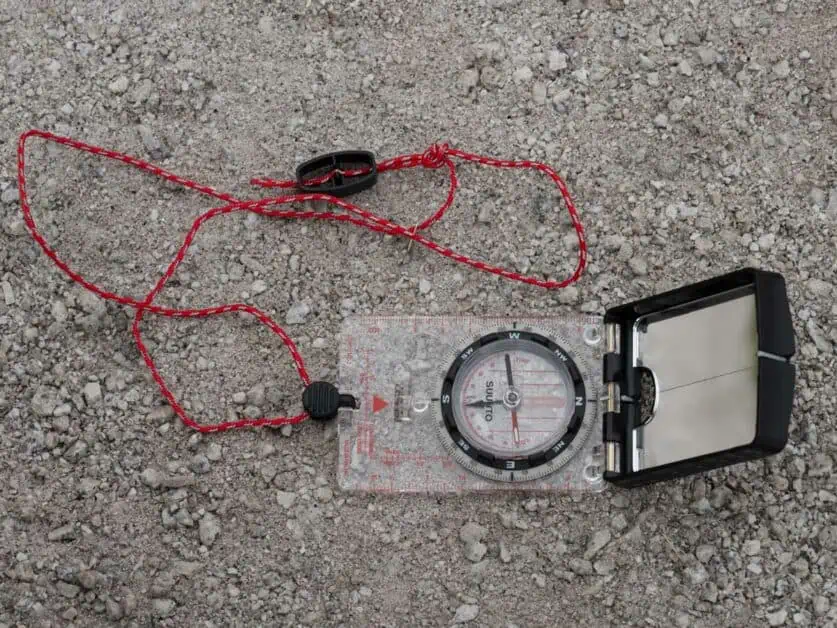
Military-Style or Lensatic
A lensatic compass, also known as a military-style compass, has a hinged sighting lens that users look through to align the compass with a distant target, ensuring accurate readings even in challenging conditions. It also has rear and front sights to aid in taking precise sightings.
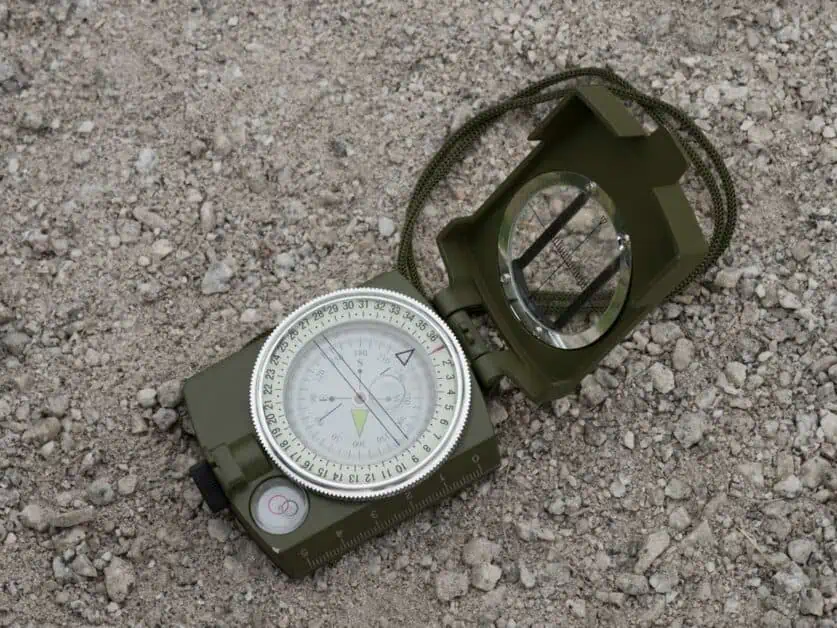
Wrist Compass
A wrist compass is a navigational tool designed to be worn like a watch on the wrist, providing users with a convenient and hands-free way to access directional information while on the move. This type of compass typically features a compact and lightweight design that includes a magnetic needle, degree markings, and often a rotating bezel for setting and reading bearings. Some have a transparent base so they can be taken off your wrist and placed on a map. A wrist compass is the most practical kind of wearable compass as it is large enough to be relatively accurate while still being portable, lightweight, and easily accessible.
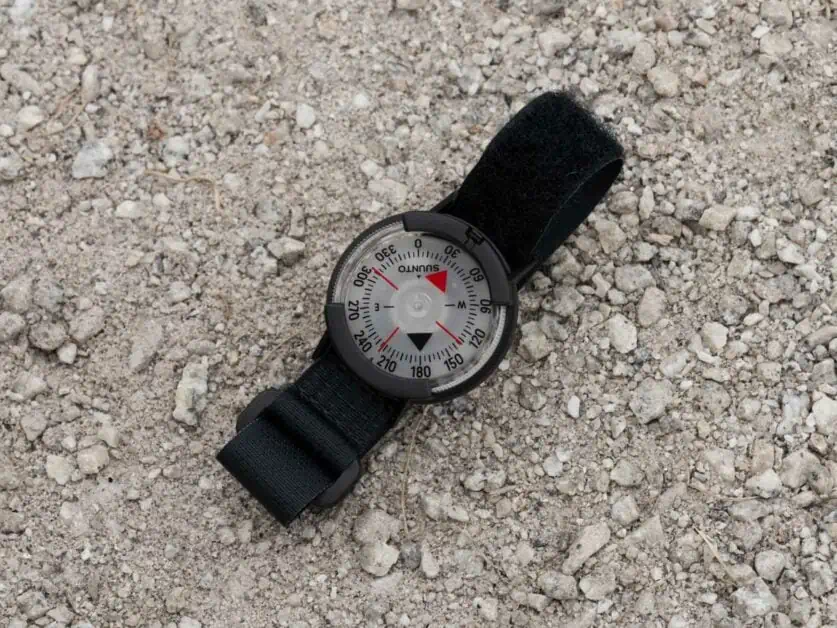
Clip-on
A clip-on compass, unsurprisingly, uses a clip or fastening mechanism to attach a compass to clothing, gear, or other objects. While it is useful to have an easily accessible compass, especially in race conditions, clip-on compasses are too small to do more than indicate the general direction of North, and they can be easily lost.
Thumb compass
Thumb compasses are used by orienteers, runners, and adventure racers who require frequent navigation updates while on the move. By wearing the compass on the thumb, users can keep their hands free for map handling and terrain negotiation. While helpful in ensuring you are going in the right general direction, their small size means they do not have any extra features and are not that accurate.
GPS
There are lots of hiking gadgets available that use GPS to navigate. They use signals from a network of satellites to determine the user’s precise location, altitude, and movement on the Earth’s surface. Equipped with a GPS receiver and often a color display, these devices provide detailed maps, waypoints, routes, and other navigational data that provide real-time position updates. Some GPS devices for hiking also offer features like altimeters, barometers, and electronic compasses to enhance the accuracy of location and direction information. These devices need a power source, so you should always carry a magnetic compass with you as a back-up.
Our Top 8 Hiking Compasses
Suunto MC-2 Compass
Pros / Reasons to Buy
- Accuracy and Reliability
- Versatile Features
Cons / Reasons to Avoid
- Higher Price Point
- Requires Experience to Use
We were very impressed with the Suunto MC-2 Compass. We are fans of Suunto products, and they have built up a reputation for practical, high-quality items. This compass has a wide range of useful features and options, and it is well-built and easy to use. Therefore, we have chosen the Suunto MC-2 Compass as our top pick. It is slightly bigger and heavier than an average compass, but this is because it is solidly made. It has adjustable declination, and the tool for adjusting it is attached to the lanyard, so you can’t lose it. The process of changing the declination is simple and straightforward. The Suunto MC-2 Compass can be ordered in a choice of five scales, and the baseplate has several scales etched on it as well as millimeters on one side and inches on the other side. There is also a clinometer and a magnifying glass built into the compass. You get a lanyard with this compass with a quick-release catch and a wrist catch, allowing it to easily be hung around your neck, attached to your wrist, or stowed in a pocket.
This is a mirror compass, so it may take a bit of practice for beginners to be confident using it. The Suunto MC-2 Compass has a generously sized mirror giving a clear reflection. The mirror has a vertical sighting line, notches, and a viewing window to help with lining up a bearing. The bezel is marked in 2-degree increments with an accuracy of 2.5 degrees. The needle is made from high-grade steel with a jewel bearing, and it moves smoothly and settles quickly in its liquid-filled capsule. You can choose between a global needle or a Northern Hemisphere needle. If you use the Suunto MC-2 Compass at night, you will find it has luminous markings on key points. Read our full review of the Suunto MC-2 Compass here.
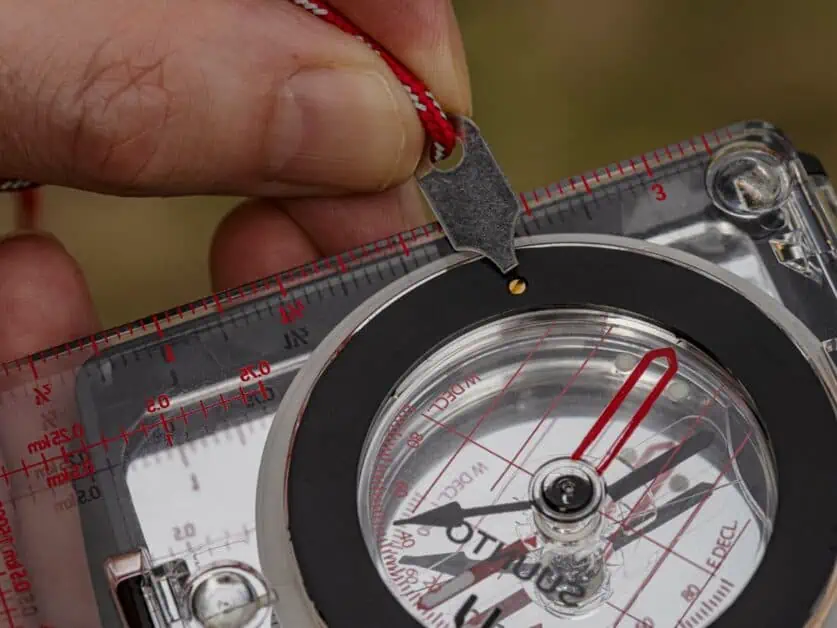
Silva Ranger 2.0
Pros / Reasons to Buy
- Precise Direction Finding
- Durable Construction
Cons / Reasons to Avoid
- Requires Experience to Use
- No Global Needle
The Silva Ranger 2.0 was a very close runner-up to the Suunto MC-2 Compass. It is equally well-built, and Silva have a well-established reputation for making innovative and reliable compasses. The build quality and materials used to make the Silva Ranger 2.0 are of a high standard, as you would expect. It is about the same size as the Suunto MC-2 Compass but weighs about twice as much, although that is only four and a half ounces. It has adjustable declination with the small screwdriver needed to make the necessary changes hidden inside the breakaway clasp of the lanyard. The declination adjustment screw is located on the bezel. The lanyard that comes with the Silva Ranger 2.0 is printed with scales so it can be used to measure the length of a hike on a map. This is a clever idea, as hiking routes are rarely straight. There are also three Romer scales and four of the most commonly used scales engraved on the baseplate of the compass as well as a useful magnifying lens. The Suunto MC-2 Compass has fewer scales. The sides are straight, with inches marked on the left-hand side and millimeters on the right-hand side. The end of the baseplate is curved to fit more comfortably in your hand.
The Silva Ranger 2.0 is a mirror compass with both a horizontal and a vertical sightline which we liked. While a mirror compass is not ideal for beginners, as it takes practice to use correctly, the Silva Ranger 2.0 has clear markings and is easy to use. The bezel comes in a choice of black or orange and is marked in increments of 2 degrees, with an accuracy of 1 degree, making it the most accurate compass we tested. This compass comes with a Northern Hemisphere needle set on a sapphire jewel bearing and a hardened steel pivot so it moves smoothly and quickly. This is an excellent compass with every feature you could ever need, including a clinometer and a slope card for assessing the steepness of slopes. The Silva Ranger 2.0 would be an excellent choice for a hiking compass. Read our full review of the Silver Ranger 2.0 here.
Suunto MB-6 Compass
Pros / Reasons to Buy
- Durable Construction
- Global Needle
Cons / Reasons to Avoid
- Requires Experience to Use
- Bulky Design
We really liked the matchbox design of the Suunto MB-6 Compass. You pull the lanyard to slide the compass out of its case, and a mirror drops down underneath. This is ideal if you are looking for a compass to keep in a pocket. It doesn’t have thin, sharp corners like a typical baseplate compass, and because the compass is wholly enclosed, it is totally protected. It does make the compass more bulky and deeper than a baseplate compass, but it is still very light and less than an inch deep.
There are lots of features packed into the Suunto MB-6 Compass. It is made from tough plastic with a steel mirror. The global needle on a jeweled bearing is in a liquid-filled capsule with a 20-degree tilt tolerance. This is a mirror compass, so if you have not used this type of compass, you may need practice and training. To use the mirror, you need to hold the compass up to eye level as the mirror is below the compass. The markings are clear and easy to read, with luminosity on the main areas so the compass can be used at night. The bezel is clearly marked with white numbers on a black background in 2-degree increments with an accuracy of 2.5 degrees. While there are straight edges to this compass, it doesn’t have any kind of scales or a magnifying lens which you may miss if you are primarily navigating by map. You can also use the Suunto MB-6 Compass as a clinometer if you need to assess a slope. Read our full review of the Suunto MB-6 Compass here.
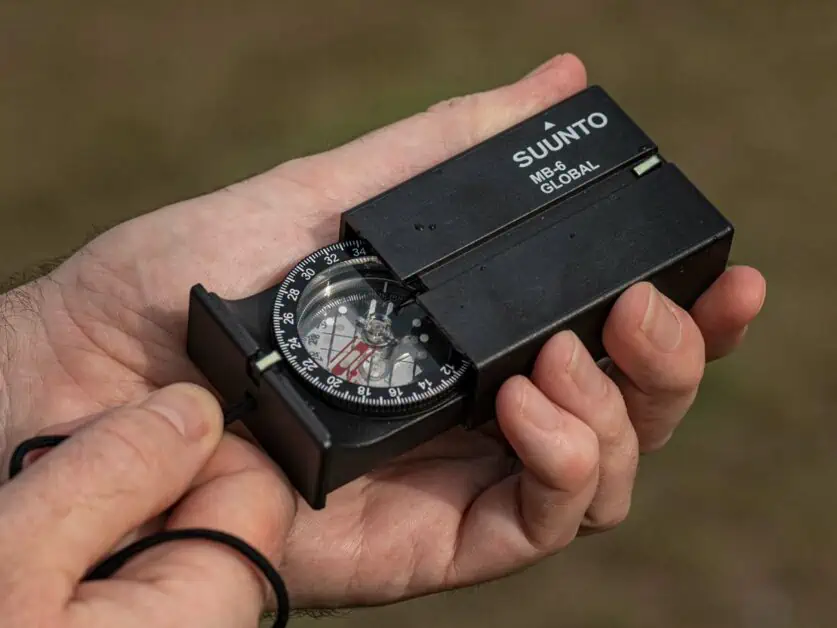
Suunto A-10 Compass
Pros / Reasons to Buy
- Lightweight and Compact
- Budget-Friendly
Cons / Reasons to Avoid
- Limited Features
- Basic Base Plate
The Suunto A-10 Compass is a good basic baseplate compass at a low price. This is an excellent choice if you are looking for a budget hiking compass. It has all the features you need, and it is easy to use and well-made from high-quality materials. Even though it is a budget compass, it is as durable as Suunto’s more expensive models. It is waterproof and will operate in cold and hot weather. It has a liquid-filled capsule housing a high-quality stainless steel needle on a jewel bearing. The compass is entirely transparent with a black bezel with clear white degree markings. It has 2-degree increments with an accuracy of 2.5 degrees. The Suunto A-10 Compass is small and light, with a curved end to make it more comfortable to hold.
As the Suunto A-10 Compass is a basic budget compass, it lacks any of the advanced features you can find on more high-end versions. There isn’t an option for a global needle, so you must choose between a Northern or Southern Hemisphere needle. The sides are straight, with the left side marked in centimeters and the right edge in inches. There are no additional scales or a magnifying lens to help with map reading. There are no luminous markings, so if you need to use the Suunto A-10 Compass in low lighting or at night, you will need a torch. This compass comes with a lanyard with a quick-release catch to make it easier to transfer onto a map. There is no adjustable declination, but the Suunto A-10 Compass does have a fixed declination correction scale marked on the compass dial in red. This is an excellent orienteering compass for beginners, children, or hikers on a budget. Read our full review of the Suunto A-10 Compass here.
Brunton TruArc 10 Compass 2021
Pros / Reasons to Buy
- TruArc Global Needle
- Durable Construction
Cons / Reasons to Avoid
- Declination Adjustment Difficult to Use
- Only One Straight Edge
If you are looking for more features than a simple, basic compass but you don’t want something as complicated as a mirror or military compass, then the Brunton TruArc 10 Compass is an excellent choice. It is a baseplate compass made from double-gauge plastic. It is water resistant, and it will keep on working in both extreme hot and cold temperatures. The bezel features a magnifying lens over the bezel to make it easier to read the bearing. The degrees are in black font on a white background, and the extra magnification allows them to be in 1-degree increments. However, there is no magnifying lens to help with reading the small print on a map which some people may miss. The baseplate is etched with 4 Romer scales, and it has 5 GPS confidence circles. Instead of a standard needle, the Brunton TruArc 10 Compass is a professional-grade, rare earth magnet. This allows the compass to resist interference and maintain polarity over time, and it can tilt up to 20 degrees. It also means it can be used globally.
The righthand side of the Brunton TruArc 10 Compass is straight, while the lefthand side has an ergonomic curve so it can be held more comfortably. While this is a nice feature, it does mean that you only have one straight edge to use when plotting a course on a map which could be annoying. To be able to provide the user with both centimeters and inches, the Brunton TruArc 10 Compass has them on a reversible stick that slides in and out on the righthand side. There is adjustable declination, but instead of using a tool, it is built into the compass dial. It is challenging to get the hang of using the adjustable declination as it involves squeezing and turning the compass dial. There are plenty of luminous markings if you need to use the Brunton TruArc 10 Compass at night. Overall this is a very good hiking compass with a number of extra features, and it is very precise and easy to read. Read our full review of the Brunton TruArc 10 Compass here.
Cammenga 417 Official U.S. Military Tritium Lensatic Compass
Pros / Reasons to Buy
- Tough and Durable
- Tritium Illumination
Cons / Reasons to Avoid
- Requires Experience to Use
- Higher Price Point
The U.S. military trusts the Cammenga Lensatic Tritium Compass for a reason. Its rugged construction can withstand harsh environments while still delivering reliable readings. Military-style compasses use a lensatic system. If you learned to navigate with a baseplate compass, you will need practice and training to be able to use the Cammenga Lensatic Tritium Compass accurately. As you would expect from a compass the U.S. military use, this compass is built to last. It is waterproof, shockproof, and sand-proof. It is made from powder-coated aluminum, and the lid closes down with the thumb grip locking it closed to protect the compass. When the front sight is folded down onto the compass dial, it detaches the needle dial from the pivot to protect the delicate mechanism. Instead of a standard needle, the Cammenga Lensatic Tritium Compass has a needle dial balanced on a precision-made synthetic sapphire jeweled bearing. This is not in a liquid-filled capsule but instead in a copper-damping shell with a rubber seal. Because of this, the needle moves quickly and settles within six seconds. The Cammenga Lensatic Tritium Compass is available in various colors, including pink.
One of the unique things about the Cammenga Lensatic Tritium Compass is that it uses seven Tritium micro-lights to provide illumination at night. These are much brighter than phosphorus and do not need to be activated by a torch or daylight. However, after about 12 years, they will start to fade gradually. Due to its design and materials, the Cammenga Lensatic Tritium Compass is bulkier and significantly heavier than a baseplate compass. This compass has no extra scales or markings except for inches on the lefthand side. The increments are primarily marked in Mils, which some may find confusing if they are only used to using degrees. The increments are in 20 Mils with an accuracy of 40 Mils, and an inner circle displays degrees in 5-degree increments. However, this compass costs much more than simpler baseplate compasses. If you would like a military-style hiking compass for hiking, the Cammenga Lensatic Tritium Compass is a universally respected, top-of-the-range option. Read our full review of the Cammenga Lensatic Tritium Compass here.
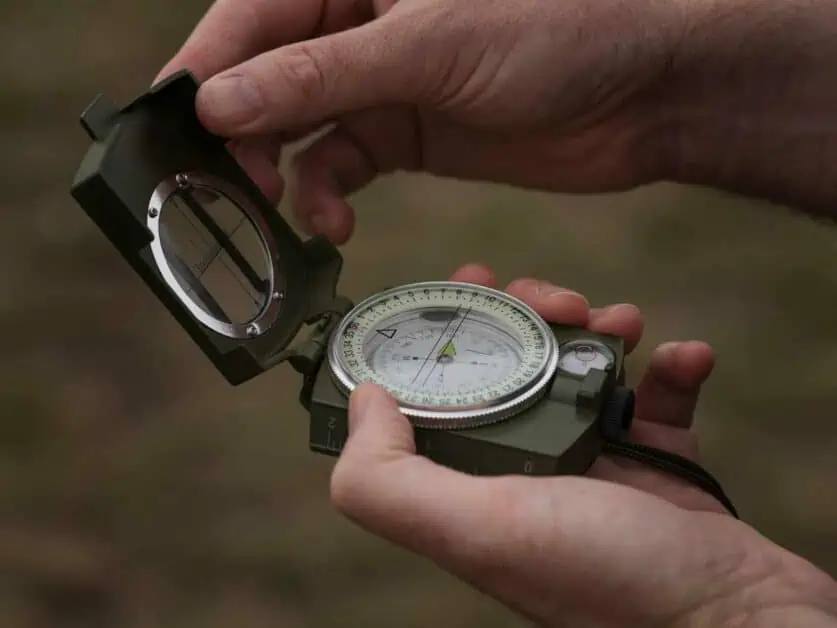
Brunton Lensatic Military Style Sighting Compass
Pros / Reasons to Buy:
- Precise Sighting
- Rugged Design
Cons / Reasons to Avoid:
- Requires Experience to Use
- Limited Features
If you’re looking for a military-style lensatic compass but you are on a budget, then the Brunton Lensatic Military Style Sighting Compass could be just what you are looking for. It is very similar in design to the Cammenga Lensatic Tritium Compass but less durable. The case and hinge are made from metal, but most of the rest of the compass is plastic. This does, however, make it lighter. The Brunton Lensatic Military Style Sighting Compass has increments in 2-degree intervals and is accurate to within 5 degrees. The front sight has a magnifying lens that helps to read the bearing and can also be used for deciphering the small writing on maps. There are several luminous markings for night use. When the case is folded out flat, you have a long straight edge marked in millimeters.
The Brunton Lensatic Military Style Sighting Compass is perfect for hikers who want both a military-style lensatic compass and value for money without sacrificing functionality. It is slightly smaller and weighs about half as much as the Cammenga Lensatic Tritium Compass, but it is not as well built. The needle is in a liquid-filled capsule and must be held level to be accurate. It also takes a while to settle and can only be used in the Northern Hemisphere. Since it is a lensatic compass, beginners who have been using baseplate compasses may need help adjusting to the different navigation system. Read our full review of the Brunton Lensatic Military Style Sighting Compass here.
Suunto M-9 Wrist Compass
Pros / Reasons to Buy
- Wearable Convenience
- Compact and Lightweight
Cons / Reasons to Avoid
- Smaller Display
- Limited Map Use
The Suunto M-9 Wrist Compass is a highly portable option that can be comfortably worn on your wrist. Despite its compact size, the Suunto M-9 Wrist Compass is still precise and dependable. As a basic compass, it is much cheaper than more feature-packed options. The Northern Hemisphere needle is in a liquid-filled capsule with a jeweled bearing. Due to its small size, this wrist compass is marked in 5-degree increments, with clear black writing on a white background. It has a side window so you can hold it up to eye level to take a bearing. It comes with a black Velcro strap that fastens firmly, and it can be adjusted to all sizes of wrists and worn over clothing and coats. Handily, this wrist compass is also waterproof, so you don’t have to protect it if you are caught in the rain while hiking. Luminous markings make reading the direction easy, even in low-light conditions or if you are on a nighttime hike.
Obviously, the small size of the Suunto M-9 Wrist Compass means it does not have any extra features like scales or clinometers. It also doesn’t have any way to allow for declination. Nor is it designed to be placed on a map for plotting a course, so it has no straight edges or magnifying lens. However, we were surprised how helpful we found it to be able to check our route by simply and quickly raising our arm. Whilst it could not be used as your primary means of navigation, the Suunto M-9 Wrist Compass would be excellent for using in tandem with a GPS device. It would also be a fun starter compass for a child. Read our full review of the Suunto M-9 Wrist Compass here.
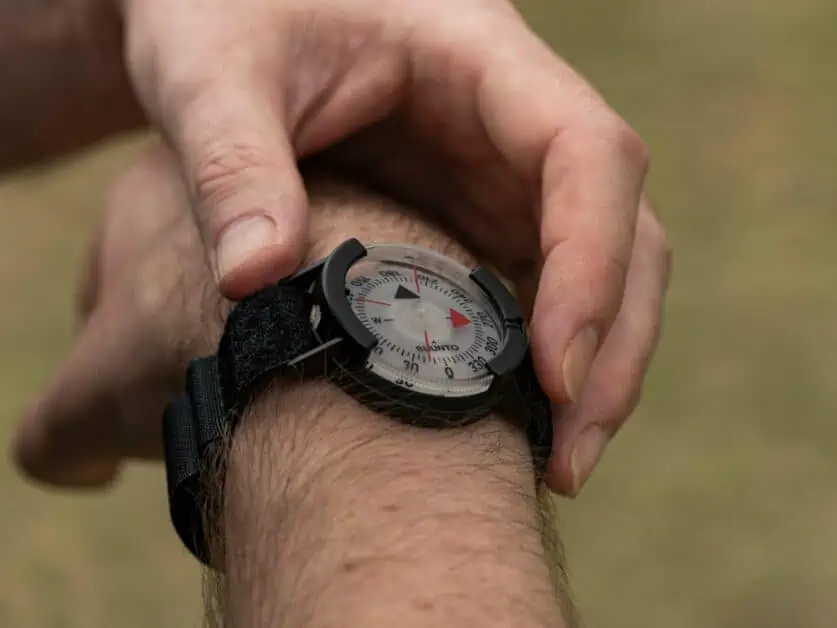
Features to Look for On a Hiking Compass
When selecting a compass for hiking, there are many factors to consider to make the best choice. Each compass offers unique advantages, from accuracy and durability to special features such as clinometers or adjustable declination.
Type
It is essential to consider what you will use the compass for. A simple baseplate compass would be sufficient if it is for occasional use or to learn the basics of orienteering. If you are regularly going hiking and you use a map for navigating, then you will want an accurate compass with adjustable declination, so consider investing in a mirror or lensatic compass. If you mainly use a GPS device and you want a magnetic compass as back-up and easy reference, then a wrist or matchbox compass might be more suitable.
Increments and Scales
Most magnetic compasses are marked in degrees, although some have Mils as well or instead. Increments usually come in 2 degrees which provides a sufficient degree of accuracy for hiking.
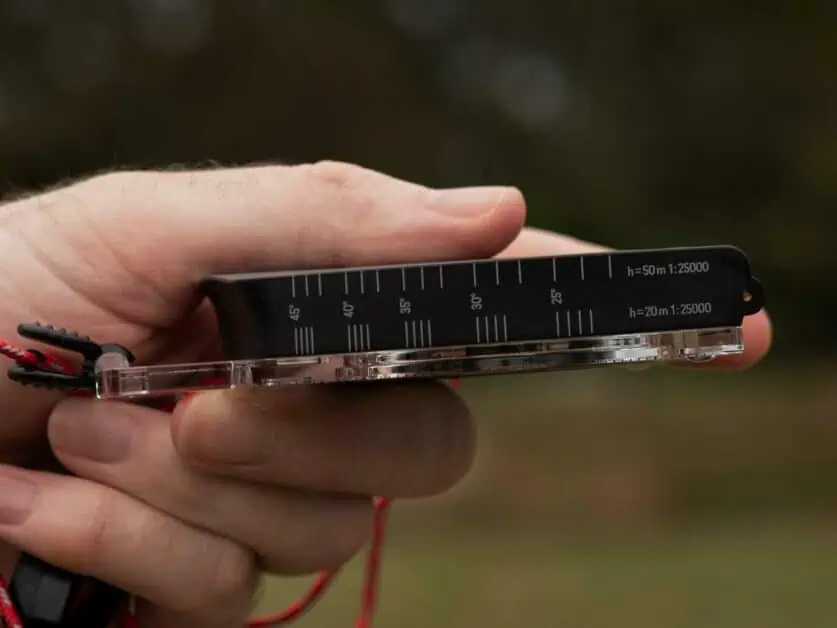
Durability
Ideally, a compass will be waterproof and robust enough to withstand the occasional knock or bump. Whilst most compasses are made from some form of plastic, it is worth checking that moveable parts such as hinges are made from metal. Some form of cover for the compass dial would provide protection from scratches.
Ease of Use
A compass is no good if you can’t use it. There’s no point in having a compass with lots of features if you don’t know how to use them. A compass also needs to be easy to read. Adjustable declination is great to have but can be fiddly to set. Some compasses come with a lanyard to go around your neck for easy access.
Region and Needle
Compass needles must be set or balanced for the specific hemisphere in which they are being used due to the Earth’s magnetic field characteristics. The Earth has magnetic North and south poles that are not aligned with its geographical North and south poles. In the northern hemisphere, the magnetic field lines point downward into the Earth’s surface at an angle. However, the magnetic field lines emerge from the Earth’s surface in the southern hemisphere. The closer you are to the poles, the more a compass needle must be adjusted. Some compasses come with global needles that can be used in both hemispheres. It is vital to check that the compass you are getting can work in your region, as even global needles do not always cover all regions.
The needle on a compass is its most important component. They have to be able to move smoothly and quickly and to settle, or dampen, quickly. The needle is often set in a liquid-filled capsule. A good compass will have a tilt tolerance built in, so you don’t have to hold it precisely horizontally for the compass to work.
Luminosity
Having the key parts of a compass glow in the dark is very useful. Even if you are not planning on hiking at night, it is a helpful feature for low-light conditions. It also means that you can still use your compass if something goes wrong and you are trying to find your way in the dark. Most luminous colors use phosphorus which needs to absorb light, from the sun or a torch, before they can emit a glow.
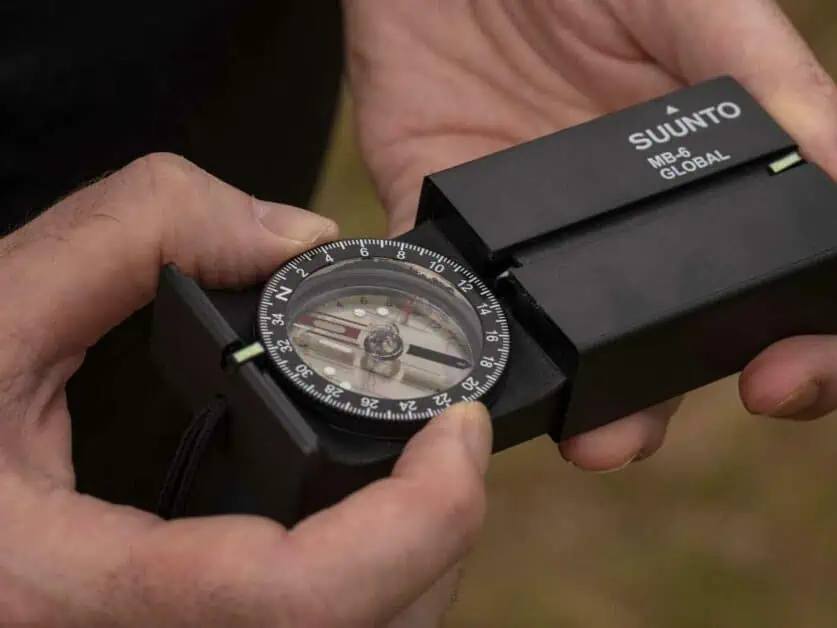
Size
Compasses are relatively small pieces of hiking equipment, but it is still essential to think about how you will use the compass. If you are planning on mainly having your compass in your pocket, then you don’t want it to be too big. The more features you have on a compass, the bigger it generally is.
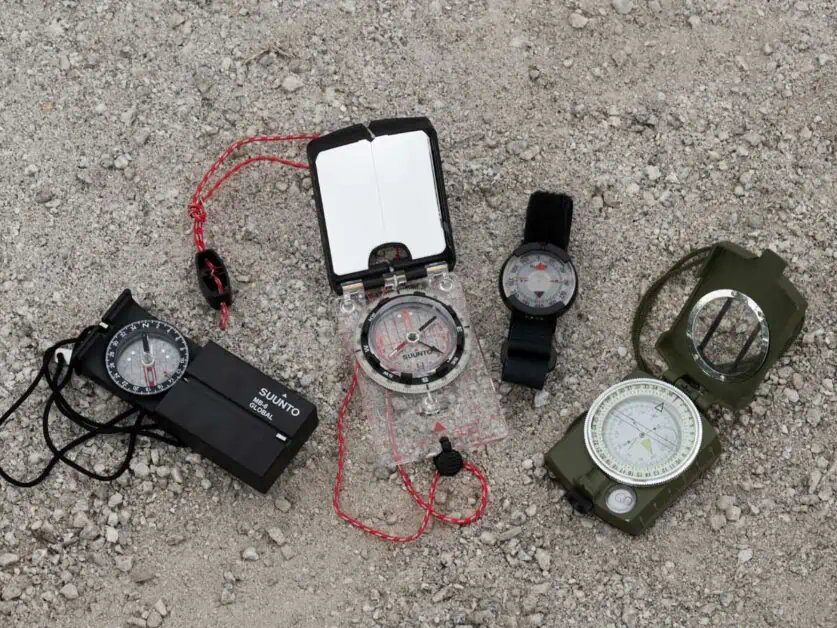
Weight
Whilst compasses are not heavy, every ounce counts if you are backpacking or going on a long hike. A simple baseplate compass can weigh only 1 or 2 ounces (30 – 57 grams), but a military-style compass can weigh as much as 7 ounces (199 grams).
Price
If you will be using your compass and relying on it for navigation a lot, it is worth investing in a good compass. Unlike electronic devices, a compass doesn’t need upgrading, batteries, or much more than basic maintenance, so a good compass should last you for decades.
How to Use a Compass
A compass is an easy tool to learn to use. There are plenty of guides online to help you get started or you can go on a course.
A Baseplate Compass
A baseplate compass is a simple tool that can be used to measure and follow directions while outdoors. It consists of a rotating circle, with a needle in the center pointing North. To use it, simply turn the baseplate to point toward your desired direction of travel, such as North or south. The compass needle will point to the magnetic north pole and help you stay on course. The baseplate also has a transparent base that allows you to take bearings from the map or other features in the landscape.
An important tip when using a baseplate compass is to make sure that you keep the needle pointing towards magnetic North at all times. This means keeping it away from any metal objects or electronic devices, such as cell phones, which can cause interference with the compass’s accuracy. Additionally, ensure that you calibrate your baseplate compass for magnetic variation before using it, as this will provide more accurate navigation.
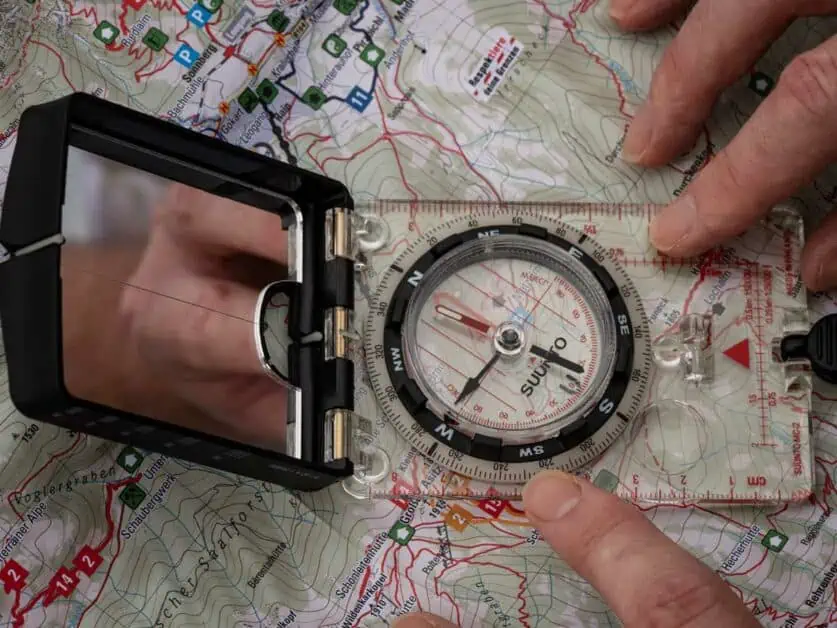
A Mirror Compass
A mirror compass works on the same basic principles as a baseplate compass, but the addition of a mirror means you can look straight ahead while also looking at the compass dial to take an accurate bearing. To use the mirror, hold the compass flat and open the hinged lid to reveal the mirror’s surface. Look through the sighting notch while simultaneously aligning the direction-of-travel arrow with the target or object you wish to sight. At the same time, ensure the mirror’s reflection of the compass’s magnetic needle is also in alignment with the direction-of-travel arrow.
A Lensatic or Military-Style Compass
A lensatic or military-style compass has a case with two hinged flaps and a sighting slot in the center. To use it, you must open the case and position yourself so that the sighting slot is aligned with your desired direction of travel. Raise the sighting lens to a 45-degree angle so you can see through it. Then, you can read off the direction from the rotating disk inside.
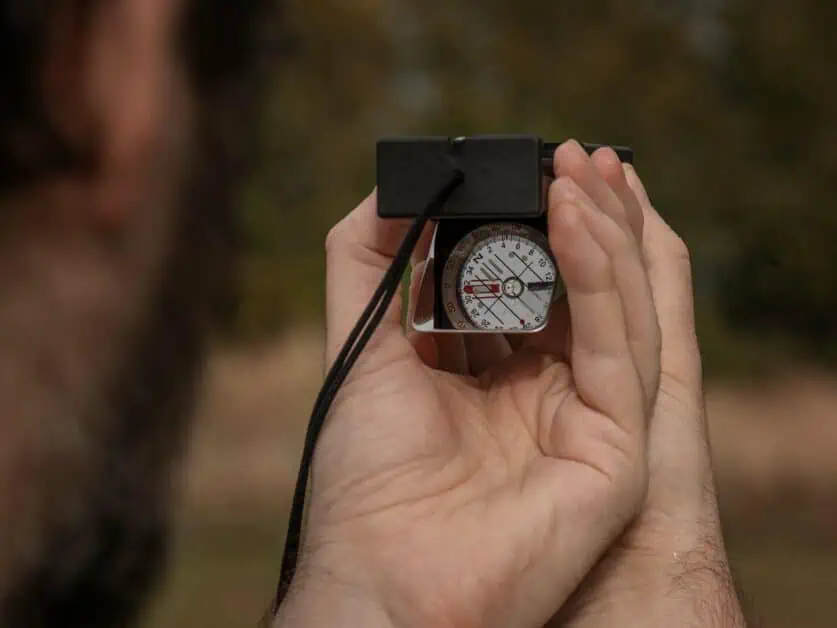
How to Store and Care for Your Compass
Keep your compass in tip-top shape for accurate navigation in the great outdoors with these practical tips.
Cleaning Your Compass
Before storing, give your compass a wipe, or if necessary a scrub, gently with a soft cloth and mild soap. Avoid harsh chemicals and dry it well to prevent moisture from affecting its accuracy.
Avoiding Magnetic Interference
Store your compass away from any magnetic sources like mobile phones and electronic devices.
Storing Properly
When not in use, keep your compass cool and dry. Excessive heat and moisture are not good for compasses.
Bubble Formation
Bubbles appearing in your liquid-filled compass are a common problem. It’s probably just altitude or temperature changes. Tiny bubbles won’t ruin your compass, but big ones might need professional attention.
Servicing & Repairs
If your compass needs more than basic TLC, leave it to the pros. DIY repairs could make things worse. If your compass keeps having problems despite your best efforts, contact the manufacturer’s customer service for guidance. Companies such as Suunto, Silva, and Brunton take pride in the products and, in most cases, are happy to help.
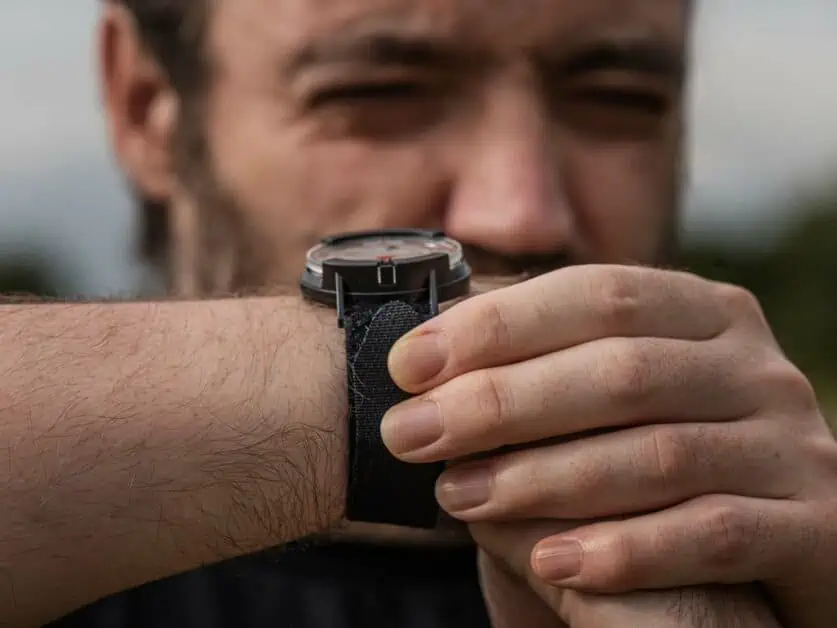
FAQ
What is the purpose of a compass for hiking?
A compass is a crucial navigational tool for hikers, helping them determine directions, navigate trails, and find their way in unfamiliar terrain, ensuring safe and accurate outdoor exploration.
What types of compasses are suitable for hiking?
Various compass types, including baseplate, mirror, lensatic, and wrist compasses, are suitable for hiking. Each kind of compass offers distinct features catering to different navigational preferences and needs.
How do I use a compass for hiking?
To use a compass, hold it flat, align it with your desired direction or target, and read the bearing indicated by the compass needle or scale. Different compass types may require specific techniques, such as sighting through a lens or using a mirror.
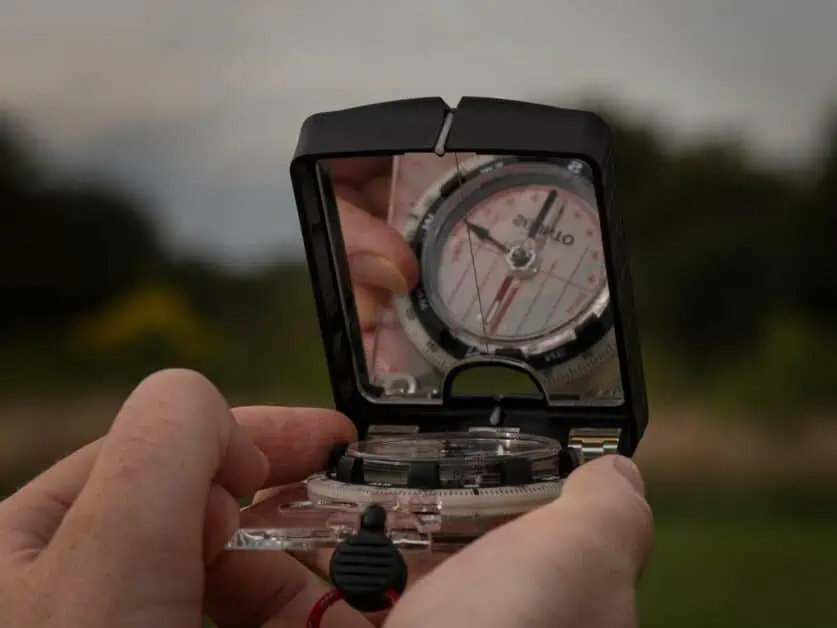
Do I need a compass if I have a GPS device?
While GPS devices are valuable tools, having a compass as a back-up is essential. Compasses do not rely on batteries and can provide a reliable directional reference even in challenging conditions where GPS signals may be weak or unavailable.
What is the difference between magnetic north and true north?
Magnetic North is the direction the compass needle points to, influenced by Earth’s magnetic field. True North is the geographic direction toward the North Pole. The difference between them is called declination, which varies by location.
How do I account for declination when using a compass for hiking?
Adjust the compass bearing by adding or subtracting the declination angle from your intended direction to account for declination. This correction ensures that your compass reading aligns with true North for more accurate navigation. Some compasses have adjustable declination or a declination scale marked on the compass dial.
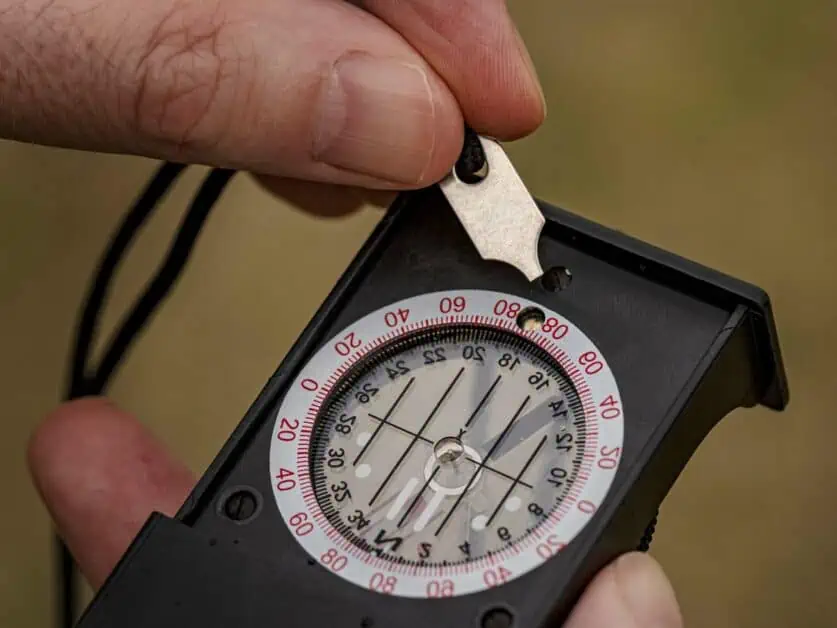
Can I use a compass for hiking in different hemispheres?
Yes, compasses are designed for specific hemispheres. Some compasses have a global needle that works in both hemispheres, ensuring accurate readings regardless of your location.
What features should I consider when choosing a compass for hiking?
Consider factors such as ease of use, durability, weight, sighting mechanisms, and additional features like declination adjustment, luminescent markings, and built-in clinometers. Select a compass that suits your navigational needs and the type of terrain you’ll be exploring.
Conclusion
Hiking compasses are indispensable for hikers, providing reliable orientation in various terrains and conditions. Each type caters to specific needs and preferences, from the traditional baseplate compasses to the specialized lensatic, mirror, and wrist compasses. The diverse range of compass designs, features, and technologies available ensures that there’s a compass suited for every adventure, whether it’s a leisurely hike or a rigorous trek. By understanding the features, benefits, and usage of various compass types, hikers can learn to navigate confidently and enjoy their adventures.
Disclaimer: This article contains Affiliate Links. You won’t pay any more for buying through these links, but we may receive a commission from any purchases made through them. As an Amazon Associate, I earn from qualifying purchases. If you choose to support us by buying through our links, we thank you as it helps us to continue providing the resources we do to help you enjoy the outdoors more!








